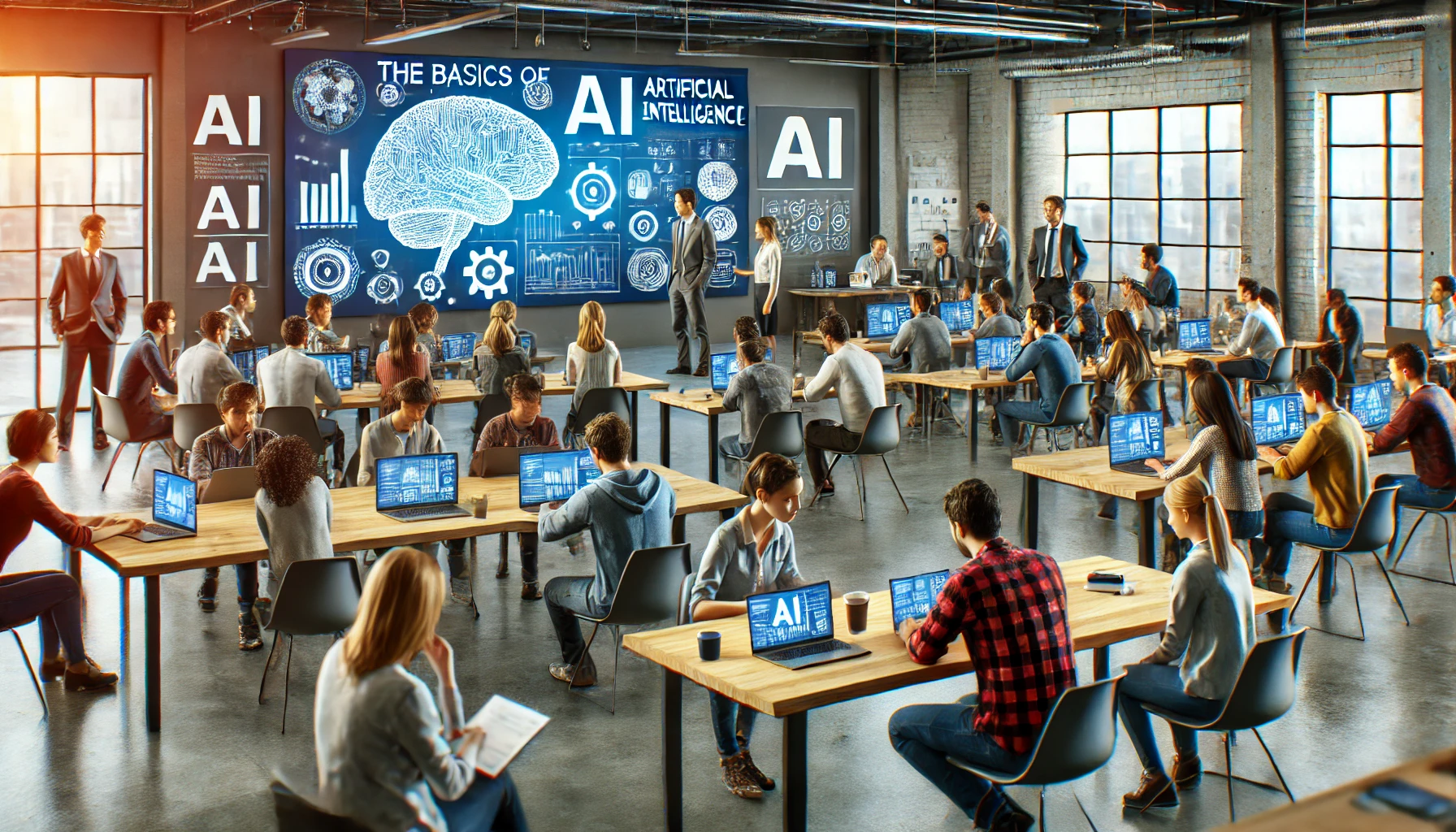
Introduction
Artificial Intelligence (AI) has moved from science fiction to everyday reality, making waves in nearly every industry. You’ve probably heard about AI in the context of self-driving cars, chatbots, or maybe even in a slightly ominous way—robots taking over jobs. But beyond the buzzwords and headlines, what exactly is AI, and how does it work?
Whether you’re a student, a professional, or simply a tech enthusiast, understanding AI basics can open your eyes to the technologies that are reshaping our world. In this article, we’ll break down the key concepts behind AI in a simple and engaging way, so you walk away with a solid grasp of what AI is, how it works, and why it’s such a big deal.
Let’s dive in.
1. What is Artificial Intelligence?
At its core, Artificial Intelligence is about creating machines that can think, learn, and make decisions—much like a human, but often much faster and more accurately. AI is not a single technology; it’s a collection of techniques that enable computers to solve problems, recognise patterns, and make predictions. Think of AI as a brain that never sleeps, constantly processing and learning from data.
AI systems are already everywhere. When you ask Siri for the weather, receive personalised Netflix recommendations, or encounter targeted ads online, AI is at work behind the scenes. AI ranges from simple chatbots to complex systems that can diagnose diseases better than doctors. To truly understand AI, it’s essential to know the two main types that dominate today’s tech landscape: Narrow AI and General AI.
Further Reading:
- For a deeper dive into AI definitions and types, check out this Beginner’s Guide to AI.
2. How AI Works: The Basics
So, how does AI actually work? At a high level, AI is about feeding data into algorithms to help machines “learn” from patterns. Imagine teaching a child to identify animals—you show pictures of cats and dogs, label them, and eventually, the child recognises the animals on their own. AI learning follows a similar process but on a much larger, faster scale.
Here’s a breakdown of how AI works:
- Data Collection: AI thrives on data. This data could be anything from text and images to numbers and speech. For example, to train an AI system to recognise faces, it needs thousands of photos to learn what different faces look like.
- Processing and Learning: Machine Learning, a subset of AI, is the main method that helps AI learn from data. Algorithms sift through the data, find patterns, and “learn” from these patterns. There are different types of learning, such as supervised learning (where AI learns from labelled data) and unsupervised learning (where it finds patterns on its own).
- Decision-Making: Once AI has processed enough data, it can make decisions or predictions. For example, AI in healthcare can predict a patient’s risk of developing a disease based on their medical history and current symptoms.
AI isn’t just about complex algorithms; it’s about continuous learning and adaptation, much like how humans improve over time.
Further Reading:
- Explore more about Machine Learning and its impact.
3. Types of AI: Narrow AI vs. General AI
When it comes to AI, not all systems are created equal. The AI we encounter today mostly falls into the category of Narrow AI, designed to perform specific tasks like language translation or image recognition. Think of Narrow AI as a specialist—it’s incredibly good at one thing but clueless about everything else.
Examples of Narrow AI:
- Voice Assistants: Siri, Alexa, and Google Assistant help you set reminders, play music, and answer questions.
- Recommendation Systems: Platforms like Netflix and Amazon use AI to suggest shows and products you might like.
General AI, on the other hand, is more like a human brain—capable of understanding, learning, and applying knowledge across various fields. While General AI is the ultimate goal, it’s still largely theoretical and presents significant technical challenges. Imagine an AI that could seamlessly transition from diagnosing a disease to writing a novel; that’s General AI, and we’re not quite there yet.
Further Reading:
- For a comparison of AI types, check out this AI Overview.
4. Core Components of AI: Neural Networks, Data Processing, and NLP
AI relies on several foundational technologies that allow it to function effectively. Here’s a closer look at the most critical components:
- Neural Networks: Inspired by the human brain, neural networks consist of interconnected nodes (neurons) that process information. These networks are crucial for AI tasks like speech recognition, image analysis, and predictive analytics. They allow AI to perform tasks that once seemed impossible, such as creating art or driving cars.
- Data Processing: AI needs to handle vast amounts of data to find patterns and make decisions. Advanced data processing techniques enable AI to analyse this data efficiently, making sense of complex information in seconds.
- Natural Language Processing (NLP): NLP is what allows AI to understand, interpret, and respond to human language. From chatbots that answer customer questions to voice-activated assistants, NLP is the driving force behind making AI feel more human.
Further Reading:
- Learn more about Neural Networks and their applications.
5. Everyday Examples of AI: Bringing AI Into Your Daily Life
AI isn’t confined to tech labs or big corporations; it’s integrated into many aspects of our daily routines. Here are some common examples:
- Smart Assistants: Devices like Siri, Google Assistant, and Alexa use AI to understand voice commands and perform tasks, making your life a bit easier. Ask Alexa to play your favourite song or get the latest news update—AI makes it happen.
- Recommendation Engines: Ever wonder how Netflix seems to know exactly what you want to watch next? That’s AI at work, analysing your past viewing habits and suggesting new shows or movies.
- E-commerce: Online shopping sites use AI to personalise your shopping experience. From targeted ads to product recommendations, AI ensures you see what you’re most likely to buy.
- Healthcare: AI-powered diagnostic tools help doctors detect diseases like cancer early on, sometimes even better than human specialists. For example, AI can analyse thousands of medical images quickly, spotting patterns that are invisible to the naked eye.
- Self-driving Cars: Companies like Tesla and Waymo are pioneering autonomous vehicles, which rely on AI to navigate roads, avoid obstacles, and make split-second decisions.
Further Reading:
- For more on AI in everyday life, check out this overview of AI applications.
6. Why AI Matters: The Impact of AI on Industries and Society
AI is more than a convenience; it’s a transformative technology with the potential to revolutionise industries and improve our quality of life. Here’s a look at some of the most impactful areas:
- Business Operations: AI is reshaping the business landscape by automating routine tasks, enhancing customer service with chatbots, and predicting market trends. For example, AI-driven analytics help companies optimise their supply chains and reduce costs.
- Healthcare: From drug discovery to personalised treatment plans, AI is making healthcare more precise and accessible. AI systems can predict patient outcomes and suggest tailored therapies, improving the quality of care.
- Transportation: The development of autonomous vehicles is set to revolutionise transportation, making roads safer and reducing human error. Imagine a world where traffic jams are a thing of the past, thanks to AI-powered traffic management systems.
- Finance: AI is a game-changer in the financial sector, where it helps detect fraudulent transactions, assess credit risks, and even automate trading. Financial institutions use AI to analyse market data in real-time, making quicker and more informed decisions.
Further Reading:
- Explore how AI is transforming business with these industry insights.
7. Conclusion: Embracing the Future of AI
Artificial Intelligence is not just a buzzword; it’s a fundamental shift in how we interact with technology and solve complex problems. From the mundane—like getting directions on your smartphone—to the groundbreaking—like diagnosing diseases or driving cars—AI’s impact is undeniable and only set to grow.
As AI continues to evolve, it will bring new opportunities and challenges. The key to harnessing its full potential lies in understanding its basics, staying informed, and being open to its applications. Whether you’re a business leader looking to optimise operations or a tech enthusiast excited about the next big thing, AI is the frontier of innovation.
So, keep learning, stay curious, and be ready to engage with the AI-driven world of tomorrow.

